Micromax Canvas 4: Benchmark and Camera Performance

Today, we have with us the recently launched Micromax Canvas 4. We give you a look at the benchmarks scores and the performance of the smartphone's camera.
Today, at the Digit Labs, we have with us the Micromax Canvas 4.
At the launch event, we had some time to take a look at the features and specifications the smartphone brings to the table, but we didn’t have the time or the resources to see how it performs in the benchmark tests.
If you are interested in going through the features of the smartphone, you can do so in our Canvas 4 first impressions.
The Canvas 4’s specifications remain close to its predecessor, the Canvas HD, and the new smartphone will see some serious competition from a wide range of quad-core smartphones in the Rs. 13,000 to Rs. 20,000 price range.
Here is a quick look at the specifications of these smartphones.
|
Models
|
Micromax Canvas HD
|
Micromax Canvas 4
|
Karbonn Titanium S9
|
iberry Auxus Nuclea N1
|
Xolo X1000
|
Xolo Play
|
Lava Iris 504Q
|
Xolo Q1000
|
Spice Stellar Pinnacle Pro
|
Zen Ultrafone HD
|
|
OS
|
Android 4.2
|
Android 4.2
|
Android 4.2
|
Android 4.2
|
Android 4.0
|
Android 4.1.1
|
Android 4.2
|
Android 4.2
|
Android 4.2
|
Android 4.2
|
|
Display Size
|
5-inch
|
5-inch
|
5.5-inch
|
5-inch
|
4.7-inch
|
4.7-inch
|
5-inch
|
5-inch
|
5.3-inch
|
5.3-inch
|
|
Display Type
|
IPS LCD
|
IPS LCD
|
IPS LCD
|
IPS LCD
|
TFT LCD
|
NA
|
IPS LCD
|
IPS LCD
|
IPS LCD
|
IPS LCD
|
|
Display Resolution
|
1280×720
|
1280×720
|
1280×720
|
1920×1080
|
1280×720
|
1280×720
|
1280×720
|
1280×720
|
960×540
|
1280×720
|
|
Built-in storage
|
4GB
|
16GB
|
16GB
|
4GB
|
8GB
|
4GB
|
4GB
|
4GB
|
16GB
|
4GB
|
|
Expandable storage
|
up to 32GB via a microSD card
|
up to 32GB via a microSD card
|
up to 32GB via a microSD card
|
up to 64GB via a microSD card
|
up to 32GB via a microSD card
|
up to 32GB via a microSD card
|
up to 32GB via a microSD card
|
up to 32GB via a microSD card
|
up to 32GB via a microSD card
|
up to 32GB via a microSD card
|
|
Processor
|
1.2GHz quad-core
|
1.2GHz quad-core
|
1.2GHz quad-core
|
1.5GHz quad-core
|
2GHz single-core with multi threading
|
1.5 GHz (4 1 core) NVIDIA Tegra 3
|
1.2GHz quad-core
|
1.2GHz quad-core
|
1.2GHz quad-core
|
1.2GHz quad-core
|
|
RAM
|
1GB
|
1GB
|
1GB
|
1GB
|
1GB
|
1GB
|
1GB
|
1GB
|
1GB
|
1GB
|
|
Rear Camera
|
8MP
|
13MP
|
13MP
|
13MP
|
8MP
|
8MP
|
8MP
|
8MP
|
8MP
|
8MP
|
|
Front Camera
|
2MP
|
5MP
|
5MP
|
8MP
|
1.3MP
|
2MP
|
2MP
|
1.2MP
|
5MP
|
3.2MP
|
|
Dual-SIM
|
Yes
|
Yes
|
Yes
|
Yes
|
No
|
No
|
Yes
|
Yes
|
Yes
|
Yes
|
|
Battery
|
2000mAh
|
2000mAh
|
2600mAh
|
2800mAh
|
1900mAh
|
2000mAh
|
2000mAh
|
2100mAh
|
2550mAh
|
2000mAh
|
|
Price
|
Rs. 13,850
|
Rs. 17,999
|
Rs. 19,990
|
Rs. 18,000
|
Rs. 17,899
|
Rs. 15,999
|
Rs. 13,499
|
Rs. 14,999
|
Rs. 14,990
|
Rs.11,999
|
Coming to the performance of the Canvas 4, the smartphone booted up quite quickly and its interface feels quite smooth as well. The “blow to unlock” feature worked well, but we don’t see you using it too much. When the “blow to unlock” feature is enabled, you can’t use the traditional swipe to unlock feature on the smartphone. You will have to disable the blow feature to use the traditional unlocking method on the smartphone.
Since the hardware under the hood of the Canvas 4 is at par with a lot of the budget quad-core smartphones available in the market, we take a look at how it performs in the benchmark scores when compared to the likes of the Lava Iris 504Q, Xolo Q1000, Spice Stellar Pinnacle Pro, the A116 Canvas HD and the Zen UltraFone HD.
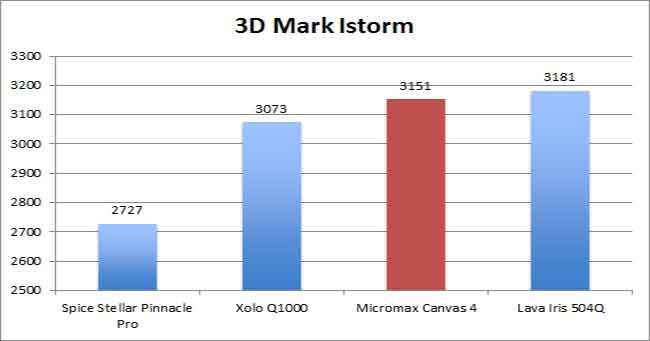 |
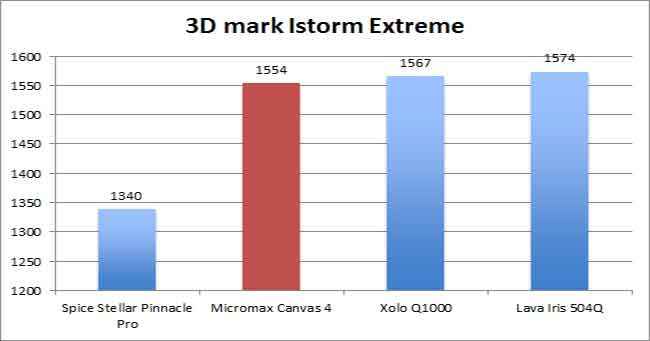 |
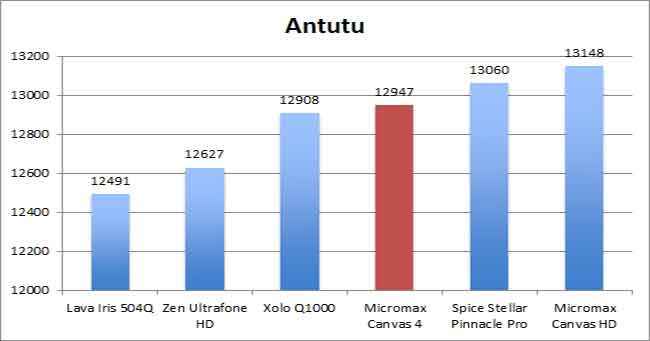 |
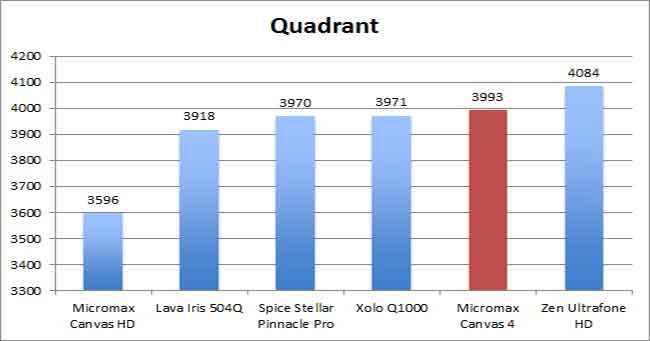 |
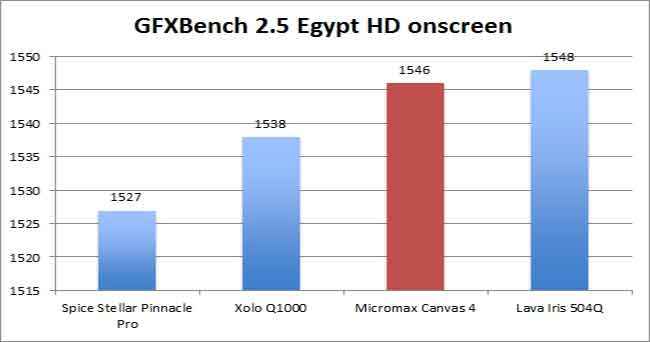 |
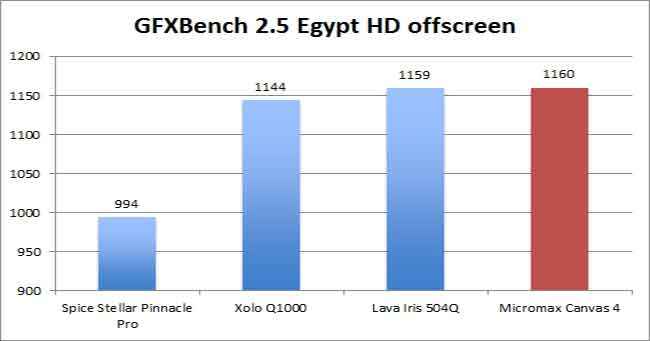 |
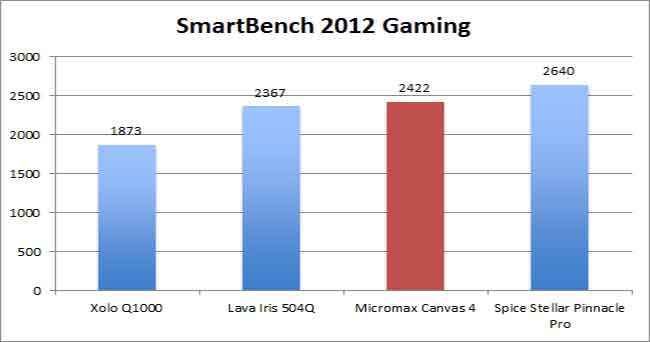 |
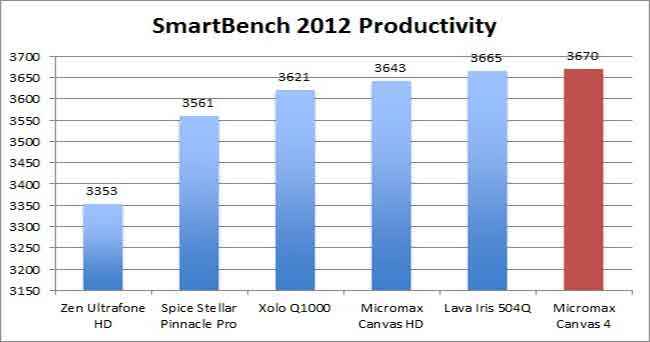 |
As you can see from the above benchmarks, the performance of the Canvas 4 isn’t groundbreaking when compared to what the competition has to offer. There are some benchmarks where the Canvas 4 has the highest scores, but the margin isn’t great. In other benchmarks it scores in the middle of what the competition has to offer.
Coming to the camera of the Canvas 4, we see it has a 13MP rear shooter. We are happy to say that the performance of the camera on the Canvas 4 is really good. Put simply, it scores a 3.5 out of 5. The detail in the images is really good. If you have a foreground which is dull, and a background which is bright, the images aren’t that great when clicked from your average budget smartphone. Here, the images are good. You will notice a bit of noise if you view the image at 100%, but that is acceptable.
-small.jpg) |
-small.jpg) |
-small.jpg) |
-small.jpg) |
-small.jpg) |
-small.jpg) |
-small.jpg) |
On the downside, the camera of the Canvas 4 is a tad slow. Auto focusing takes time and if you whip out the phone and instantly click a picture, it might be blurry. You also need to be still when clicking the images, as they will turn out shaky if your hands are shaky.
-small(1).jpg) |
-small(1).jpg) |
-small(1).jpg) |
Nevertheless, we are quite impressed with the performance of the camera of the Canvas 4. You can use this camera to take pictures of the kids birthdays and special occasions and be happy with the results. The quality of images is good to click and share on social networking websites.
Even though the hardware of the Canvas 4 hasn’t produced groundbreaking results, the camera is something that we are really impressed with. We would like to put the phone through its paces and see how it performs when it comes to real world usage before giving our final verdict.
Sameer Mitha
Sameer Mitha lives for gaming and technology is his muse. When he isn’t busy playing with gadgets or video games he delves into the world of fantasy novels. View Full Profile




